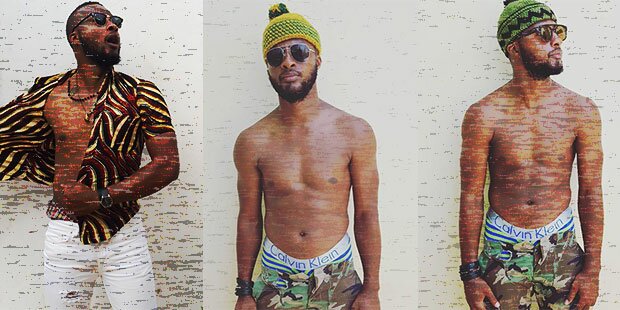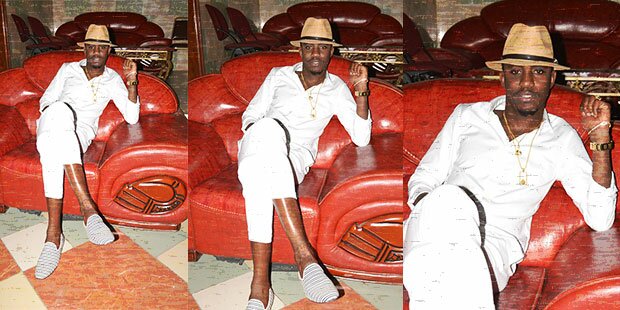Sweeping through the Senegalese press these days is one of those periodic outbreaks of hysterical denunciation that social scientists call a moral panic. Everyone, it seems, is writing alarmed screeds about the fashionable clothing being affected by Dakar youth, which seems to be a stylish bricolage of hipster and African-American fashions. It is clearly a homosexual plot, most writers conclude. Anna Louise Sarr here, writing in Sud, does not differ in the conclusions, but she takes a deeper dive than most, trying to hear, through the generation-gapped buzzing in her ears, the actual voices of Dakar’s young trendsters. What she hears seems to be a true counterculture: youths being told, and even believing, that what they are wearing and listening to and doing is immoral, and doing it anyway.
Tchekelma, pinw, bodys in v-neck or crewneck, bright, floral colors: all part of a style that covers up the masculinity of young men while it exposes their bad character. We are in the era of effeminate men.
Young people never stop surprising us with the way they plagiarize their clothing styles. They plunge into unisex fashions that play on mingling and contrast. Afro haircuts, colorful bodys [tanktops], skinny jeans, ankle boots…a look that makes them appear more woman than man. But so what, as long as they are ‘in.’ Your reporter talked to some of them, to try to understand what motivates them, and to see what they know about how and by whom these fashions are transmitted.
And listening to them, it turns out that these young people are aware of how much their clothing choices are disliked, they understand the impact of their androgynous appearance, they know what they are bringing down on themselves by wearing certain outfits in religious contexts.
Mohameth NGom, 17, will buy anything fashionable, and he is just fine with that. Leaning against the wall of a house in Dieuppeul, he calmly poaches the WiFi, saying with assurance that yes, “I wear the pinw[skinny, short pants tight at the ankles]”, the “check down”[saggy jeans]and the “body.” Doubtless, he is trying to connect with his generation, with his moment in time; he is all plugged into fashion, even at the risk of electrocuting himself. Dressed in khaki shorts and a blue tanktop that sticks to his body like a second skin, he is in the spirit of the times; young men like him, with their androgynous dressing style, are legion. What seems to matter to them is being identified with the crowd, with seeming “in.”
As for parental control, Mohameth is unconcerned. “My father grumbles about my get-ups, but he does not seem angry with his comments, just makes them in passing,” Mohameth says. Well aware of the not-exactly-respectable origins of these fashions, he nevertheless insists that they do not tarnish his image in the slightest, since everyone is doing it. It is the Senegalese ‘grawoul’ (it’s no big deal): just another form of the laxness by which we legitimate unacceptable conduct by consent of the majority.
“I know it is the homos who wear pinw,” he says, “but I am not afraid people will accuse me of being a homo, because I am not. And yeah, I know it was American convicts who started the check down fashion because they walk around without belts. But nowadays, everybody dresses like that; it’s not just the homos who dress like that. Being fashionable doesn’t mean believing in the ideas of the homos or the convicts. It’s just about being like everybody else,” he claims.
The danger that hangs over this oblivious “boy town” is that he himself is sending out non-verbal signals suggesting he is something he is not. He is presenting himself to the homosexual community as one of their own: without realizing it, he is transmitting by way of the clothes he wears, a code that some might misinterpret. And so one fears the worst: his actions could trigger reactions whose seriousness could surprise him, and he could find himself caught all at once in a vicious circle!
Cheikh Sadibou Diop [an opposition political figure]believes that the clothing styles affected by young people is neither a matter of chance or naivety; at times it actually reflects their sexual inclinations. And as incredible as it may seem, their peers take heed, trade in accusations. “The youth know the origin of pinw, and when you are in your circle of friends, your buddies make fun of you: ‘You got caught boy! Fegn ga!’ (you’re a fag!) “This look is evil,” Cheikh insists. “The youth speak truth to each other. But nevertheless there are those who dress like this, to fit in or out of ignorance. They imitate for fun. Youth must dress properly to be presentable. People judge you from afar based on your look and pigeonhole you even before getting to know you. When you dress well, people respect you, you make a favorable first impression.”
The opinions of others on their clothing eccentricities do not bother the youth, unless those opinions are accompanied by repressive measures. Between the stick of suppression and the carrot of useless verbiage, they frequently surf-and sometimes just dive and accelerate-into the forbidden. As long as they confine themselves to simple remarks, the pack of public opinion can bark as loud as it likes; the caravan of mannequins will just keep marching by. But faced with firmness, they reconsider their Boule Fale [Bugger Off] attitude; they take a step back, seriously change their tune, and basically punt the ball to get out of trouble. The jalabe and the ganila, spare clothes that will be seen very positively by the notables of the mosque, are right there within reach. On Fridays, you put on your best clothes, do the ritual washing, and head to the mosque. At the mosque, there is no way to escape tradition, you must simply drop the boy town look to save your soul! These youth would never dare draw the fiery stares and the torrent of contempt that would fall on a black sheep. If they did, they would pay the price for all the intergenerational rancor in this clothing dialogue of the deaf. So it would be out of the question to stir up such controversy there.
For Mohameth, it comes down to a question of respect. “Dressing stylishly to go to the mosque would not be proper, or respectful to the grownups you find there,” he admits at last, laughing at himself. As for the two pals Boubacar and Samba, who are getting a breath of fresh air in front of their house in Skerle, they say [wearing such outfits]would bring down the rage of one and all, by so disturbing the concentration of their elders.
So if these youngsters are aware that certain outfits are appropriate for certain situations, their style of dressing is clearly on purpose, “ma téy” as they would say in their lax jargon. As plugged in as they are to fashion, Boubacar and Samba nevertheless make some responsible choices when faced with this vast arsenal. ““We don’t wear the skintight “pinw.” It’s not nice, or decent. When you wear it “dagnou lay deukkeul foo deukkoul” (you get pigeonholed). We don’t feel comfortable in that get-up.” It is clear that these youngsters perceive the close link between the appearance of a clothing style and the deeper and more hidden reality of the sexed social being (man, woman, homosexual).
Their own parents pay attention to how they dress and do not hesitate to comment. “They tell us it is not decent at all, especially when we put on “pacth” (this new word in Wolof, that refers to shorts, alluding to the shortening of the length of the trousers; the verb “khadj” means to divide); they find them short. We pay attention to our parents when we dress, because they judge us by our look.” Shorts styles have not habitually caused ethical problems amongst the young, but this year’s summer fashion has placed them under the spotlight for all age groups, thanks to the summer heat.
In the midst of all this, some parents have fortunately remained unmovable. Faithful sentries, they camp out in front of their home’s door, examining everyone, and send back the lame ducks before these teenagers can cross the threshold. To avoid these untimely and embarrassing, and occasionally humiliating, summonses, the more pragmatic youth engage in preventive actions: “Da gnouy soralé wakh yi” (we follow their commentaries), the two pals confess to us. In dressing, they take the lead so as to avoid the sidelong glances and the derogatory remarks.
Sellers of fashion clothing: doing good business whatever the cost
They are the prime movers of the apparel business, through whom all clothing distribution flows: importers bring in the whole range of fashion items of every style from around the world. And for them, nothing is off-limits. Morals be damned, business is business!
In Sandaga, out in the market stalls and inside the Touba Sandaga shopping center, the latest mens’ fashions are spread out before us. But you have to double-check to realize that they are indeed men’s fashion articles. Invariable confirmation from the sellers, accompanied by an impish smile. «Lii moo khew ci été bi» (‘it’s the fashion this summer’), says Diouma Diack, apparently finding my flustered expression amusing. Her stand, which resembles Ali Baba’s cave, sells men’s clothing. She offers numerous brands: Lion’s Head, Versace, Buscemi buckles… but what is surprising are the unexpected colors and the odd patterns. Patent leather shoes adorned with butterflies or flowers. Shirts printed with checkered patterns, in shades of pink, orange, green and blue. Colors that are as showy as they are garish, the polar opposite of masculine discretion. And to pile on the flashiness, leather hats, in all colors, caps made out of faded denim and rhinestones, and big tinted sunglasses. Jeans are always there, whether in a classic or a “pinw” style. Made of lighter material to face the summer heat. The trouser in light khaki is also hip. Shorts now called “Tchëckël ma,” Bodys with a V-neck or a crew neck, skintight t-shirts…and to really buckle the buckle: assorted belts in the same style.
If merchants here want to sell their wares, they have to defer to their customers’ tastes-even if that means selling the kind of clothing they would never consider wearing themselves.
The vendors admit they dislike “pinw” and this fashion that makes boys look like girls. Among them is Moussa Ndiaye, who gets his supplies from Luxemburg. Before making the trip, he takes the young people’s orders. “I don’t recommend skinny clothing to anyone. Men should dress like men and women should dress as women,” he says. But as for the contradiction between his words and his actions: that’s business! For Moussa, though, music, obscene dancing, and the new wrestling fad all contribute to corrupting youthful morals. According to him, it is time the authorities shoulder their responsibilities in all this.
Only two vendors out of our sample of ten categorically refuse to sell or import clothes that distort men’s looks: lonely partisans of proper and decent clothing. One is Abdou Sène: A retail dealer in his fifties, he gets his stock from wholesaler colleagues. But his conscious choice for decent menswear is not without consequences. His stand is not well stocked and when we ask to see something from a fine-fashion collection, he quickly points to the neighboring stand. “I don’t sell that type of thing,” he says, shortly. “I do not wear those get-ups, and I do not offer them to my customers. People who shop with me are responsible men who dress appropriately,” he adds. It goes without saying that he loses a lot of business this way. But that is the price Abdou has to pay by swimming against the currents of fashion. He is willing to offer trendy items to his customers, provided they are decent and respectable. But how long will he last in this competitive environment, where the customer is king, and knowing the young are the main customers here?
Another sacrificial lamb: Karim Sylla. Younger and with a more laid-back look, in his forties, he runs a shop in the Touba Sandaga shopping center. His merchandise is diversified, but his stock does not sell quickly. It comes from China for the most part. He refuses to import indecent fashions, thus reducing his client base. “In this store, I have no visibility,” he complains. “I do not know the internet sites that do e-commerce. My Facebook page does not get a lot of views. Only one person has come to the store after reading my blog. The others spend their time giving me likes rather than sales.” To solve his problem, Karim would have liked to learn about e-commerce websites for a greater visibility of his merchandise.
His competitors who are “in” do not need publicity to get rid of their stock. Lamine Diouf, a nearby merchant, simply sends some text messages and his customers come running for the new delivery. On average, the containers arrive every 40 days. What kind of fashion lines does he stock? He pays attention to what the hippest young people are wearing, but tries to avoid importing played-out styles that are already omnipresent around Senegal.
The situation cries out for the authorities to step in and shoulder their responsibilities to be certain-but also demand action from those who are currently profiting from it. Hugues, a finance student from Gabon whom I met at a soccer field in Dieuppeul, offered this thought: “If we want young people to stop wearing pinw, extravagant colors, and skin-tight bodys, then the merchants have to take a more educational, as opposed to purely profit-oriented role–and parents and teachers will have to take heed of the appearances of these young people,” he said. Finally, he called on celebrities to behave responsibly instead of perverting the youth.
Anna Louise Sarr Translated from French by International Boulevard
25 Sep 2015






































